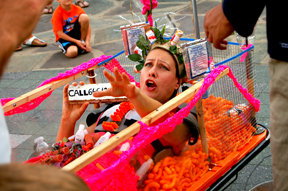When was the last time a junk food made you consider your own personal output of trash? Or moving bodies in an open park made you think about climate change?
Odd questions, but Secaucus resident and art administrator Edward Henkel hopes such questions are provocative enough to generate discussion about how we treat the environment.
This week Henkel will present his first “MovementTalks” panel discussion at the Secaucus Public Library and Business Resource Center, a discussion that will address how dance and performance can create awareness about social issues and generate political action.
“MovementTalks came from the idea that most people experience dance as either entertainment or as a social activity,” Henkel said. “And they don’t even know that dance can function as an educational tool, or as an agent for social change.”
For his panel at the library, which will take place Tues., Nov. 9 at 8 p.m., Henkel has invited three well-known choreographers – Jill Sigman, Christopher Caines, and Hilary Easton – to discuss how they use their work as artists to educate audiences and the public about environmental issues.
“Most people experience dance as either an entertainment or as a social activity” – Edward Henkel
________
What’s Cheetos got to do with it?
Sigman, whose background is in classical ballet and who has been a choreographer since the early 1990s, has, she said, “migrated into more and more experimental realms” of movement in recent years.
Sigman now creates interactive performance pieces that are meant to take place in such public spaces as parks, subway stations, and sidewalks. Among the pieces she has created recently is one titled “Our Lady of Detritus.”
In this performance piece, Sigman approached strangers in public places and talked to them about the amount of trash they generate in a typical day. Willing participants were then invited to shovel Cheetos on top of Sigman’s outstretched body. The more people shoveled, and the more covered Sigman became, the more her “audience” became aware of their own daily output of trash.
“In general, I’m interested in using movement, dance, and my body to get people to think and to raise philosophical questions about the world around us. I think the body is a very powerful tool. People tend to respond to it in ways that are very different from how they respond to words. People might be willing to encounter something or feel something that the body can present to them that words might not.”
“There are different kinds of learning patterns,” Henkel agreed. “People can learn so much through physical learning, through physically embodying what they’re trying to grasp, or making a physicalization out of ideas and facts.”
Because the “Detritus exercise” was interactive, fun, and relied heavily on a common snack food, Sigman said participants found the exercise, and the message that went along with it, “less preachy and less intimidating” than many traditional stage-based performances.
“There are different kids of learning patterns,” Henkel agreed. “People can learn so much through physical learning, through physically embodying what they’re trying to grasp, or making a physicalization out of ideas and facts.”
At the panel, Caines will discuss his piece “Human Countdown,” which was commissioned by the global nonprofit organization Oxfam, to bring awareness of global climate change.
Performed on Sept. 30, 2009, “Human Countdown” relied on about 2,500 volunteers who performed the piece in Central Park’s Wolman Rink. In the piece, the dancer-volunteers moved to create an image of the earth dissolving through an hourglass. Audiences of the piece – who were, again, members of the public – had to view the piece from above to see the full effect of performance.
Caines, who said he had never created such a piece previously, added that he personally learned a lot about climate change while creating “Human Countdown.”
“I had to do a lot of research in the course of this. You know, what’s already happening. How already melted is the Greenlandic Ice Cap? How big is the hole in the ozone over Antactica? How much of the Antarctic Ice Shelf has melted? The statistics are really intimidating, so I learned a lot of facts along the way.”
Human Countdown was part of Oxfam’s Climate Wake Up Call, a series of international events timed to coincide with the United Nations’ Climate Conference, held last year in Denmark.
First in a series
Henkel, a former dancer and choreographer himself who now is the assistant director at the 92nd Street Y/Harkness Dance Center in New York City, said this week’s MovementTalks will be the first in a series. The next one will be a panel on dance and education, and another on dance and disabilities.
“Each one will be a take on how dance can be used in ways other than entertainment,” said Henkel.
E-mail E. Assata Wright at awright@hudsonreporter.com.
